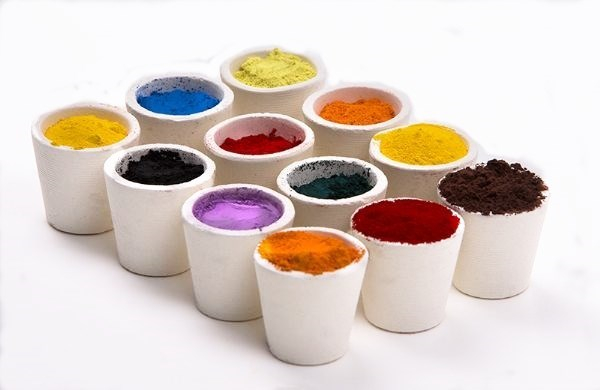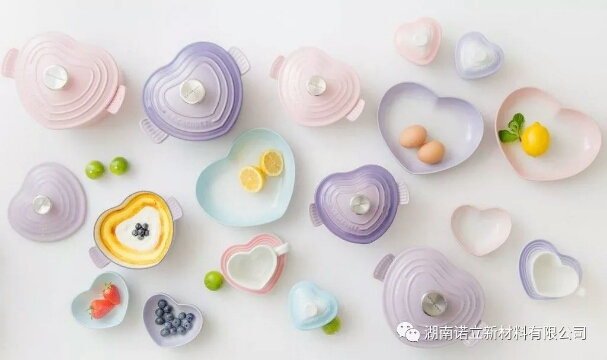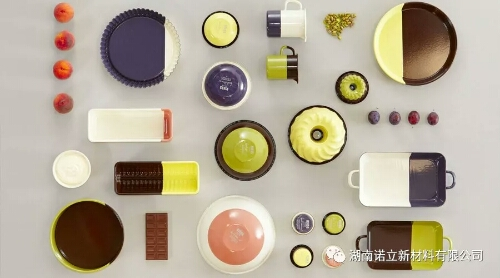Nolifrit Enamel Pigments Classification
There are two methods for enamel coloring. Adding colored oxides into enamel melt or grinding enamel frit and pigment with water into enamel slurry. Most of enamel pigments are solid solutions formed by various oxides or compounds, and their crystal structures are complex and with various types. Enamel Pigment Company divides common enamel pigments into the following types.

(1)Spinel pigments have the general formula XO•Y2O3. In the spinel, X is a divalent cation such as Cobalt, Nickel, Copper, Zinc, Magnesium, Iron, Manganese, Calcium, etc., and Y is a trivalent cation such as Chromium, Manganese,Iron, Aluminum, etc. Spinel pigments have high chemical stability and high temperature stability and can be used for coloring other enamels except for titanium enamel.
(2)Cadmium pigments include Cadmium yellow pigment with Cadmium Sulfide (CdS) and Cadmium red pigment with Cadmium Selenide Sulfide (CdSes). The color of this type of pigment is directly related to the Selenium in its composition. The amount of Selenium increases, and the color changes from yellow to orange to red. Cadmium pigments are generally only used in transparent enamel frit or semi-transparent enamel frit.
When used, Cadmium pigments sometimes produce a misty sulfate film on the enamel surface. This is due to the oxidation of the partial sulfide of the pigment to sulfate. It can be solved by appropriately reducing the melting point of the enamel or increasing the firing temperature. To remove the matt film that has been produced, rinse the surface of the enamel with water, drain off it, and then re-fire the product. In addition, for safety, Cadmium pigments cannot be used in enamel cookware and tableware that contact with food.
(3)Wrapped pigment: Due to the high temperature stability of Cadmium pigments in enamel is not so good, it may decompose above 880 °C. While when wrapped with high temperature resistant chemically stable and transparent Zirconium Silicate crystals, the Cadmium pigment can be still stable in temperatures up to 1400°C. Such pigments include red, orange, and yellow, which have been widely used in the ceramic industry, and can also be used in enamel. The Wrapped pigment should be added to the ball mill 1 hour before the enamel slurry is ground to the specified fineness. If the ball milling time is too long, the crystal structure of the Zirconium Silicate will be destroyed, and the Cadmium pigment will lose the protective layer and decompose at high temperature.
(4)Zirconium and Tin-based pigments: These pigments are formed by combining of colored oxide and colorless Zirconium Silicate or Tin oxide. They are important coloring pigments in ceramics. Because of their light color, they are often used as colorants in light enamels.
Typical colors of zirconium pigments are: zirconium iron red, yttrium yellow, vanadium blue, vanadium zirconium yellow, green, etc.
Tin-based pigments are: peach red, atomic red, rose red.
Due to the presence of various reducing impurities in the enamel frit, such pigments often cause partial fading, and white spot defects will appear on the surface of the enamel after firing, which can be overcome by grinding 0.5% soda ash in the enamel slurry.

(5)Pearlescent pigments: Pearlescent pigments reflect light multiple times and produce a pearl-like or fish-scale glittering effect on the enamel surface. Pearlescent pigments made from ordinary muscovite cannot withstand the high temperatures of enamel firing. The pearlescent pigment for enamel is made of high-temperature synthetically synthesized fluorophlogopite mica flakes, and the hydrate of titanium dioxide is coated on the mica. The pearlite effect is produced by the difference in refractive index between the titanium dioxide and the mica, and the refractory like tin dioxide is coated on to resist the erosion of pearlescent pigments by enamel at high temperature.
Pearlescent pigments are sensitive to the firing temperature, and the lower firing temperature is beneficial to them. It can only be used in special transparent enamel frit, and it’s should be noticed that invisible components can’t be added, otherwise it will effect the pearlescent effect. When used, the pearlescent pigment cannot be ground together with the enamel frit. After the enamel frit is ground, it’s time to add the pearlescent pigment and mix it evenly.

Enamel factory always mill the enamel pigment together with transparent frit, and make it into colored enamel slurry. Like the opacifier, the pigment is distributed in the enamel slurry in a finely dispersed state. The pigment particles suspended in the enamel space cause selective absorption of light and scattering of light, thereby making the enamel opaque and dyed, and finally the enamel product is produced with a beautiful appearance.
Related Searches:
enamel pigment for sale
enamel pigment
enamel paint pigments
glaze pigment enamel
iron pigmented enamel
pigments for enamel paint